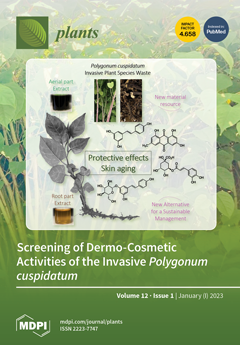Clonostachys rosea, an ascomycetous, omnipresent, cellulose-decaying soil fungus, has been reported to be a well-known mycoparasitic biological control agent. In this study, we isolated
C. rosea, a mycoparasitic fungus for the first time in India from sclerotia of the notorious plant
[...] Read more.
Clonostachys rosea, an ascomycetous, omnipresent, cellulose-decaying soil fungus, has been reported to be a well-known mycoparasitic biological control agent. In this study, we isolated
C. rosea, a mycoparasitic fungus for the first time in India from sclerotia of the notorious plant pathogen
Sclerotinia sclerotiorum, causing head rot disease in cabbage. A total of five mycoparasitic fungi were isolated from the sclerotial bodies of
S. sclerotiorum (TNAU-CR 01, 02, 03, 04 and 05). All the isolates were tested under morpho-molecular characterization. Among them, TNAU-CR 02 showed the greatest mycelial inhibition of 79.63% over the control. Similarly, the SEM imaging of effective
C. rosea isolates indicated the presence of numerous conidia destroying the outer cortex layers of sclerotia. Metabolite fingerprinting of
C. rosea TNAU-CR 02 identified 18 chemical compounds using GC-MS analysis. The crude antibiotics of
C. rosea TNAU-CR 02 were verified for their antifungal activity against
S. sclerotiorum and the results revealed 97.17% mycelial inhibition compared with the control. Similarly, foliar application of TNAU-CR 02 at 5 mL/litre on 30, 45 and 60 days after transplanting showed the lowest disease incidence of 15.1 PDI compared to the control. This discovery expands our understanding of the biology and the dissemination of
C. rosea, providing a way for the exploitation of
C. rosea against cabbage head rot pathogens.
Full article






